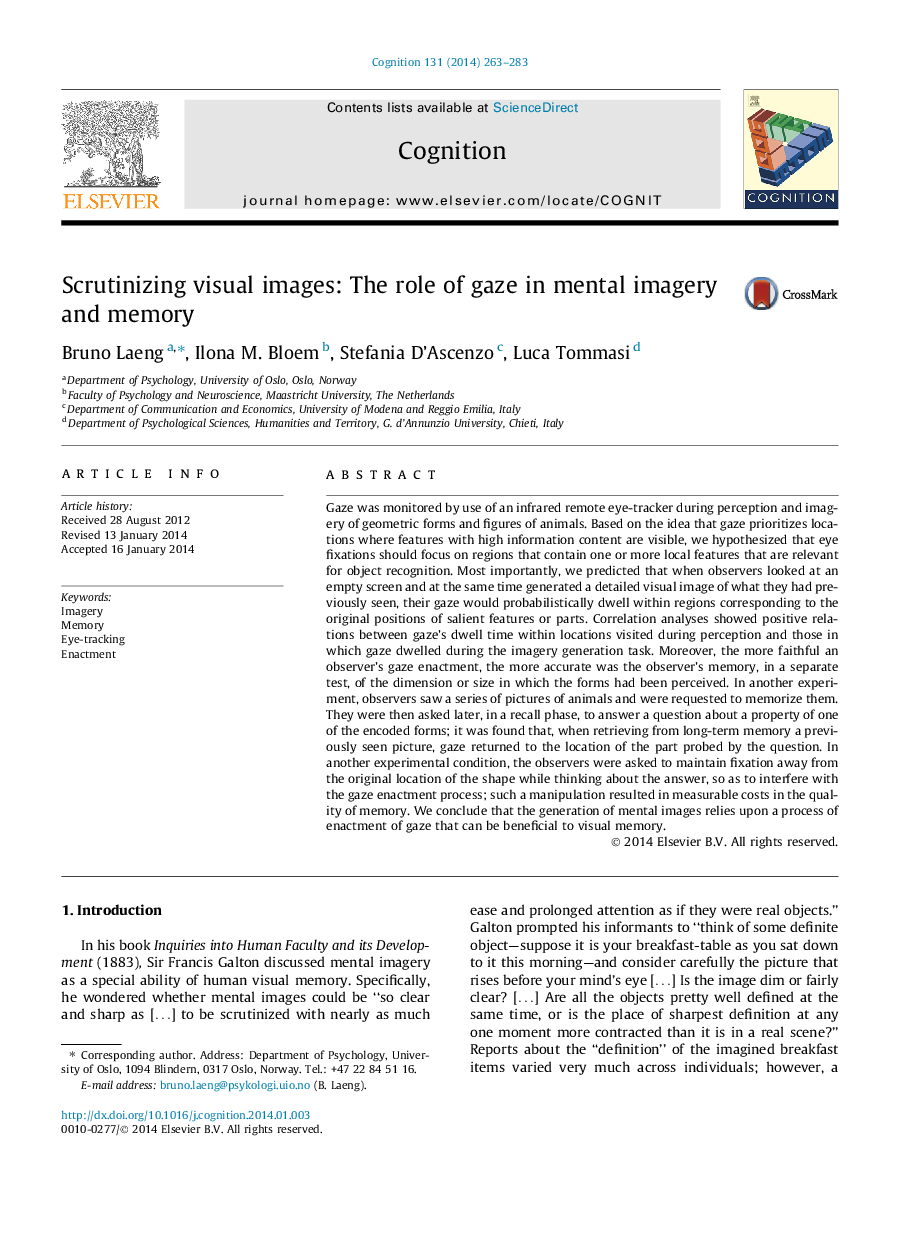| کد مقاله | کد نشریه | سال انتشار | مقاله انگلیسی | نسخه تمام متن |
|---|---|---|---|---|
| 10457561 | 921844 | 2014 | 21 صفحه PDF | دانلود رایگان |
عنوان انگلیسی مقاله ISI
Scrutinizing visual images: The role of gaze in mental imagery and memory
ترجمه فارسی عنوان
بررسی تصاویر بصری: نقش چشم در تصویر ذهنی و حافظه
دانلود مقاله + سفارش ترجمه
دانلود مقاله ISI انگلیسی
رایگان برای ایرانیان
کلمات کلیدی
تصاویر حافظه، ردیابی چشم، تصویب،
ترجمه چکیده
با استفاده از یک چشم انداز از راه دور مادون قرمز در طول تصور و تصور از اشکال هندسی و ارقام حیوانات، غزه تحت نظارت قرار گرفت. با توجه به این ایده که تماشای مکان هایی را که ویژگی های محتوای با محتوای بالا را برجسته می کنند، اولویت بندی می کند، ما فرض کردیم که تأیید چشم باید بر مناطق متمرکز باشد که دارای یک یا چند ویژگی محلی باشند که برای تشخیص ابعاد مربوطه باشد. مهمتر از همه، ما پیش بینی کردیم که وقتی ناظران روی یک صفحه خالی نگاه می کردند و همزمان یک تصویر بصری دقیق از آنچه که قبلا دیده بودند ساخته شده بود، چشم آنها احتمالا در داخل مناطق متناظر با موقعیت های اصلی ویژگی های برجسته یا قطعات است. تجزیه و تحلیل های همبستگی روابط مثبت بین زمان خلوت دید در نقاط دیدنی در طول ادراک و کسانی که در طول نگاهی به کارهای تولید تصاویر دیدند، روابط مثبت داشت. افزون بر این، بیشترین مصدومیت یک چشم انداز ناظر، دقیق تر، حافظه ناظر، در آزمون جداگانه ای از ابعاد یا ابعادی بود که اشکال درک شده بود. در یک آزمایش دیگر، ناظران یک سری تصاویر از حیوانات را مشاهده کردند و خواستار حفظ آنها شدند. بعدا آنها را در یک مراحل یادآوری خواسته شد تا به یک سؤال درباره مالکیت یکی از فرمهای کد شده جواب دهند. متوجه شدیم که هنگام بازیابی حافظه بلند مدت یک عکس قبلا مشاهده شده، نگاهی به محل مورد بررسی شده توسط این سوال بازگشت. در یک شرایط آزمایشی دیگر، ناظران خواسته شدند تا زمانی که تفکر درباره پاسخ را در نظر بگیرند، فیشینگ را دور از محل اصلی شکل قرار می دهند تا دخالت در روند تصدیق نگاه کردن؛ چنین دستکاری باعث هزینه قابل اندازه گیری در کیفیت حافظه شد. ما نتیجه می گیریم که نسل تصاویر ذهنی بر فرآیند اعمال زلزله متکی است که می تواند برای حافظه بصری سودمند باشد.
موضوعات مرتبط
علوم زیستی و بیوفناوری
علم عصب شناسی
علوم اعصاب شناختی
چکیده انگلیسی
Gaze was monitored by use of an infrared remote eye-tracker during perception and imagery of geometric forms and figures of animals. Based on the idea that gaze prioritizes locations where features with high information content are visible, we hypothesized that eye fixations should focus on regions that contain one or more local features that are relevant for object recognition. Most importantly, we predicted that when observers looked at an empty screen and at the same time generated a detailed visual image of what they had previously seen, their gaze would probabilistically dwell within regions corresponding to the original positions of salient features or parts. Correlation analyses showed positive relations between gaze's dwell time within locations visited during perception and those in which gaze dwelled during the imagery generation task. Moreover, the more faithful an observer's gaze enactment, the more accurate was the observer's memory, in a separate test, of the dimension or size in which the forms had been perceived. In another experiment, observers saw a series of pictures of animals and were requested to memorize them. They were then asked later, in a recall phase, to answer a question about a property of one of the encoded forms; it was found that, when retrieving from long-term memory a previously seen picture, gaze returned to the location of the part probed by the question. In another experimental condition, the observers were asked to maintain fixation away from the original location of the shape while thinking about the answer, so as to interfere with the gaze enactment process; such a manipulation resulted in measurable costs in the quality of memory. We conclude that the generation of mental images relies upon a process of enactment of gaze that can be beneficial to visual memory.
ناشر
Database: Elsevier - ScienceDirect (ساینس دایرکت)
Journal: Cognition - Volume 131, Issue 2, May 2014, Pages 263-283
Journal: Cognition - Volume 131, Issue 2, May 2014, Pages 263-283
نویسندگان
Bruno Laeng, Ilona M. Bloem, Stefania D'Ascenzo, Luca Tommasi,
